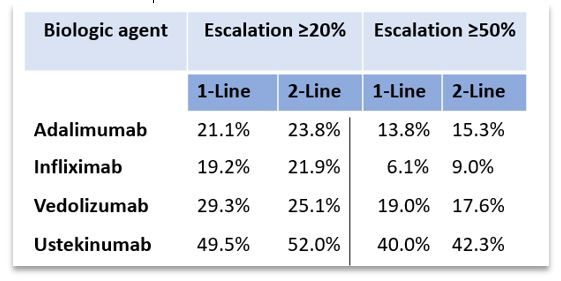In Crohn Disease, Biologic Dose Escalation is Common During Maintenance Phase, Study Reveals
"A meaningful percentage" of individuals with Crohn disease are treated during maintenance with biologic doses ≥20%higher than recommended in FDA labeling.
After reaching a maintenance dose of biologic therapy for Crohn disease (CD), continued dose escalation was found to be common practice with many individuals, regardless of biologic agent prescribed and whether the treatment was first- or second-line, according to new data presented at the 2024 Crohn’s & Colitis Congress, January 25-27, 2024, in Las Vegas, NV.
Investigators stressed the importance of better understanding of patterns of use of the agents to help guide real-world cost management.
In their abstract, study authors underscore the reality of loss of response to biologic agents and identify increase in dose as one solution observed in clinical practice. Given the potential to increase the overall cost of CD management, they set out to assess real-world dosing of adalimumab (ADA), infliximab (INF), vedolizumab (VED), and ustekinumab (UST), looking specifically at the rate and magnitude of dose escalation in a sample representative of US adults with CD.
For the retrospective cohort study, researchers tapped the IQVIA PharMetrics database for adult Americans who were diagnosed with CD and initiated treatment with one of the advanced treatments listed between January 1, 2015 and May 31, 2021. They identified the study index date as the start date of one of the 4 biologic agents.
Inclusion criteria were at least 12 months of continuous enrollment in a health plan, pre- and post-index date; no claims submitted for any of the biologics during the pre-index period; and no record of autoimmune disease or indeterminate colitis. The research team assessed both rate of dose escalation and the magnitude of the increases from the date of a participant’s maintenance phase with a prescribed biologic through the end of study follow-up.
For the purpose of the study investigators defined dose escalation as “an increase in average dose ≥20% than expected dosing per US Food and Drug Administration label during follow-up period after maintenance dose was reached.” Escalations were measured in both first- and second-line settings. They were also interested in and tracked more substantial dose increases of 50% and greater and 100% and greater, according to the study.
FINDINGS
From the IQVIA PharMetrics database, the researchers reported identifying 7353 individuals with CD who initiated a biologic agent in a first-line setting, a group with a mean age of 38 years, approximately half (51.4%) women, and with follow up data for a median of 28.5 months. Of this group, 1608 (29%) individuals, according to the abstract, received biologic treatment in a second-line setting.
They found that more participants reached a maintenance dose of a biologic agent in a first-line treatment setting (89.4%, infliximab to 93.8% adalimumab) than in a second-line setting (77.4%, infliximab to 90.3% ustekinumab).
Researchers reported the rate of dose escalation for each of the 4 biologics studied in the first- and second-line settings and at the defined level of 20% or greater and additional level of 50% or grater as follows:
Gorritz M et al.

They found that dose escalation greater than 100% was rare for both first- (0.6%, adalimumab to 10.1%, vedolizumab) and second-line (0%, adalimumab to 7.7%, vedulimumab) therapies.
“A meaningful percentage of Crohn’s disease patients treated with adalimumab, infliximab, vedolizumab, or ustekinumab had dose escalation regardless of line of treatment,” the investigators concluded in the study abstract. The value of their findings, they reiterated, is in the insights these and similar data may provide into the actual costs of treating CD with advanced biologic therapies.
Source: Gorritz M, Tuly R, Sun K, et al. Real-world rate and magnitude of dose escalation with biologics in patients with Crohn’s disease. Abstract presented at: 2024 Crohn’s & Colitis Congress; January 25-27, 2024; Las Vegas, NV. Accessed January 25, 2024.
Clinical Tips for Using Antibiotics and Corticosteroids in IBD
January 5th 2013The goals of therapy for patients with inflammatory bowel disorder include inducing and maintaining a steroid-free remission, preventing and treating the complications of the disease, minimizing treatment toxicity, achieving mucosal healing, and enhancing quality of life.